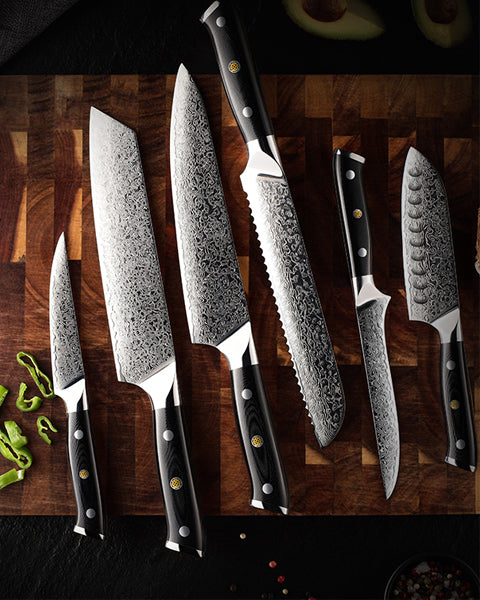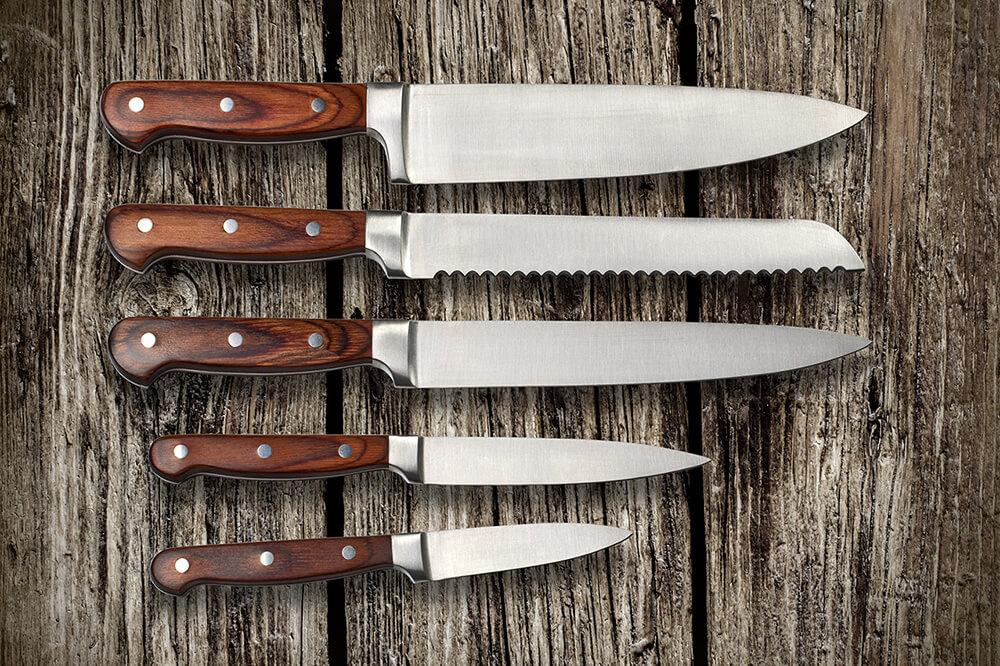You must ensure your knives are always sharp to cook quickly and safely. Preparing food with dull knives is more complex, making mistakes more likely. Choplix knives are known for being very sharp and precise but they need the same care as any other knife to keep their edge.
We will discuss the best ways to keep your CHOPLIX knives sharp and the tools you will need to do that. We will also discuss how important it is to regularly hone and store tools properly to prevent them from getting dull. Finally we will discuss why washing your knives by hand is better than washing them in the dishwasher.
You will learn about honing steel sharpening stone and using electric knife sharpeners tools you can use to keep your knives sharp. If you use the right tools and follow these tips your CHOPLIX knives will stay sharp and work well for all your cooking needs.
Why Sharpness Matters
Knives need to be sharp for more than one reason. First, using a sharp knife is better than a dull one. When you use a dull knife that takes more force you're more likely to slip and cut yourself when cutting food. A sharp blade makes cutting food easier. A sharp knife gives you more control and accuracy to make clean precise cuts.
Sharp knives work better. They require less work to use which speeds up and improves the enjoyment of food preparation. A sharp blade cuts food quickly while a dull blade can tear and crush it making the cuts random and the food look less appealing.
For the best taste and feel in your food you need very sharp knives. Sharp knives are best for cutting food because they preserve the food structure and prevent it from getting smashed or ruined. This is very important when working with delicate foods like herbs since they lose their taste quickly if they are not cut correctly.
Keeping knives sharp is essential for making them last a long time. Misusing a sharp knife is less likely to damage it because the blade is made to cut quickly. By regularly honing and cleaning your knives you can make them last longer and be helpful in your kitchen for many years.
Best Practices For Knife Maintenance
Regular Honing
Regularly sharpening your knives helps keep their edges in good shape. A knife blade can become dull over time if the edge bends or folds a little. The edge stays sharp and functional for longer between sharpenings because honing realigns it. You will need honing or sharpening steel to make your knife sharp.
Hold the honing steel straight up and down ensuring the tip is on a surface that won't slip. Hold the knife against the steel at a 20 degree angle and lightly press down on it as you move it from heel to tip. Do this a few times on each side of the blade. If you hone your knife every few uses you can keep it sharp longer and avoid having to sharpen it as often.
Proper Storage
It is important to store your knives in the right way to keep them in good shape. If you store knives in a box that is too open they may rub against other items and become dull or broken. Instead put your knives away in a knife case, a knife block or a sticky strip.
These ways to store the blades prevent them from getting dull or broken. When you put your knives away in a drawer a knife holder will keep them safe and separate from other kitchen tools. Keeping your knives in the right place keeps them sharp and helps keep you safe in the kitchen.
Handwashing
The best way to clean knives is to wash them by hand. When knives are in the dishwasher they may bump into other things which can dull them or damage them. Clean your knives with warm soapy water and dry them immediately with a soft cloth. Do not soak knives for extended periods because water can cause rusting.
Use a soft sponge or cloth and light dish soap to clean your knives by hand. Stay away from rough things that could scratch the blade. Dry the knives immediately with a towel after washing them to keep them from getting water spots and rusting. Handwashing your knives the right way keeps them clean and helps them stay sharp and last longer.
Tools For Maintaining Sharpness
Honing Steel
A honing steel also called a sharpening steel is a stick used to correct the knife edge. It doesn't make the blade sharper but straightening the edge helps keep it that way. Keep the sharpening steel upright and place the tip on a flat non-slip surface to use it. Hold the knife against the steel at a 20 degree angle and lightly press down on it as you move it from heel to tip. Do this a few times on each side of the blade.
Sharpening Stone
A sharpening stone is used to remove material from the blade to make a new sharp edge on a knife blade. Wet the cutting stone and put it on a surface that won't slip before you use it. Hold the knife against the stone at a 20 degree angle and lightly press down on it as you move it from heel to tip. Switch between the blade two sides and do this several times on each side. There are different grits of sharpening stones. Coarser grits are used on dull knives and finer grits polish the edge.
Electric Knife Sharpener
An electric knife sharpener is a handy tool for keeping knives sharp. It has polishing wheels that spin and grind the blade to give it a new sharp edge. An electric knife sharpener is easy to use. Just put the knife in it and turn it on. The sharpener automatically sets the knife to the correct angle so you don't have to do much to keep the edge sharp. Electric knife sharpeners are simple and can do the job quickly and satisfactorily.
Whetstone
A whetstone sometimes called a water stone is a tool for cutting that works best when wet. There are different grits of whetstones. Coarser grits are used to sharpen dull blades and finer grits are used to clean the edge. For use wet the stone and set it down on a surface that won't slip. Hold the knife against the stone at a 20 degree angle and lightly press down on it as you move it from heel to tip. Switch between the blade two sides and do this several times on each side. It takes some skill to use a whetstone correctly but the edges it makes are very sharp.
Knife Sharpener
Handheld sharpeners for knives are called manual knife sharpeners. They make it easy and quick to sharpen knives. Usually they have two holes for sharpening one with a coarse grit for dull blades and one with a fine grit for making the edge smooth. With a manual knife sharpener you have to put the knife in the right slot and pull it through the slot by following its curve. Switch between the blade two sides and do this several times on each side. It is easy to use a manual knife sharpener and sharpens knives well with little work.
Additional Tips For Knife Care
- Dishwasher: knives can become dull or broken when they hit other things in a dishwasher. Clean your knives with warm soapy water and dry them right away with a soft cloth. Do not soak knives for long periods of time as water can cause rusting.
- Regular Inspection: Check your knives to see if they are damaged or dull. If you see any chips, nicks or dull spots on your knife it might be time to sharpen it or get a professional.
- Use Proper Cutting Techniques: Make sure you use the correct cutting method for your food. For instance, slice bread with one hand and chop veggies with the other. If you use the proper process you can keep your knives in good shape for longer.
- Safely Store Knives: To avoid accidents ensure knives are securely stored. Use blade guards or knife blocks to protect the blades and keep them from touching other objects.
- Sharpen Your Knives Often: To keep your knives sharp you must sharpen them often. Depending on how you usually use them you may need to sharpen them every few months or as needed. A stone or an electric sharpener is the best way to sharpen something.
Benefits Of Sharpness
- Efficiency: Cutting with a sharp knife requires less force speeding up and improving food preparation efficiency. This can be especially helpful when working with tough or thick materials.
- Precision: Sharp knives are easier to control and aim allowing for more precise cuts. This is very important for jobs that must be done carefully like fileting fish or thinly chopping veggies.
- Safety: Sharp knives are safer than dull ones despite what most people think. Because it takes less force a sharp knife is less likely to slip and cut someone by mistake.
- Better Protection Against Damage: Sharp knives are easier to use and less likely to damage delicate foods like plants and tomatoes. This can make your meals look and taste better overall.
- Longer Knife Life: Keeping your knives sharp can help them last longer. It is easier to hurt dull blades which can break down faster than sharp ones.
- Professional Results: If you want to cook like a pro you need sharp knives. Sharp knives are a must have for making beautiful and tasty meals whether you're a home cook or a professional chef.
- Versatility: A sharp knife can be used for more things than a dull one. These knives are useful in any kitchen because they can be cut differently for many things.
Conclusion
For safe and effective cooking you must keep your knives sharp. If you follow these tips and use the right tools like an electric knife sharpener honing steel and sharpening stone you can keep your CHOPLIX knives sharp for years to come. To keep your knives in great shape remember to sharpen them, often store them correctly and wash them by hand. If you take care of your knives they will stay sharp and work well for all your cooking needs.











